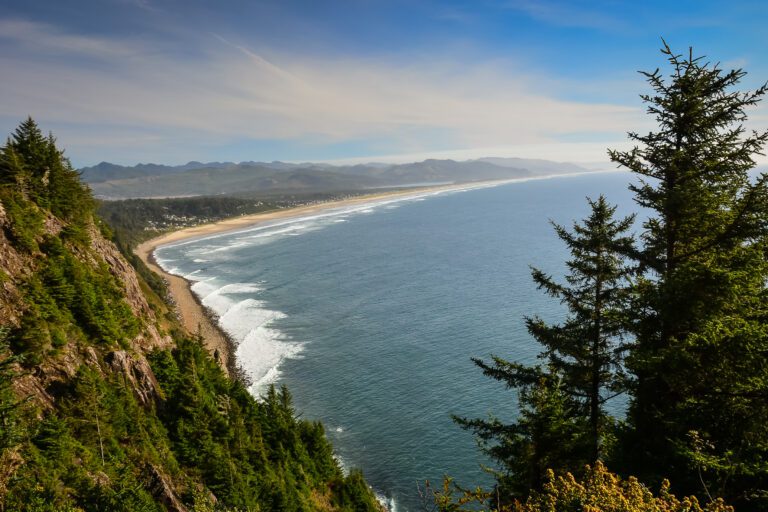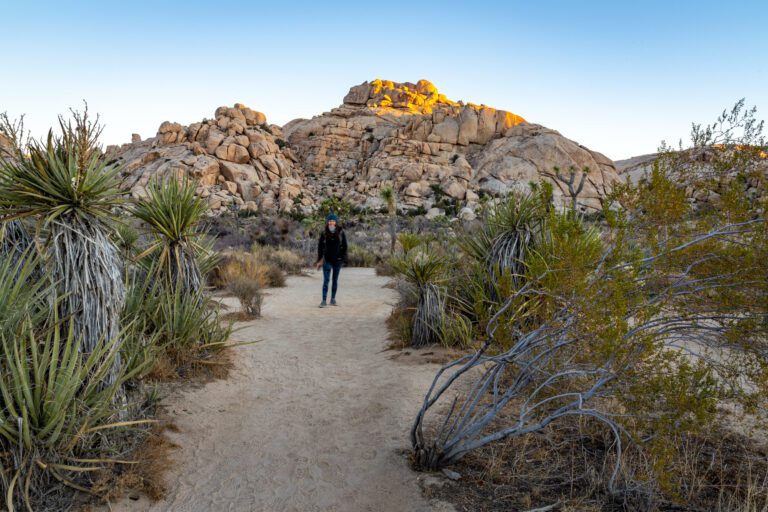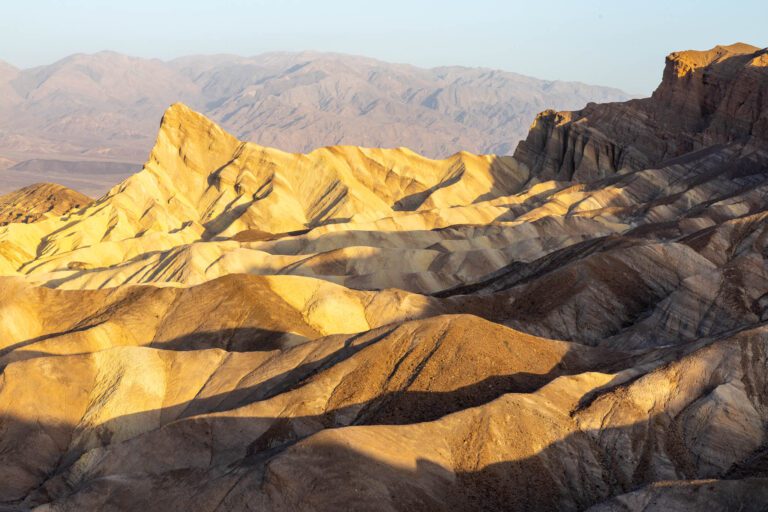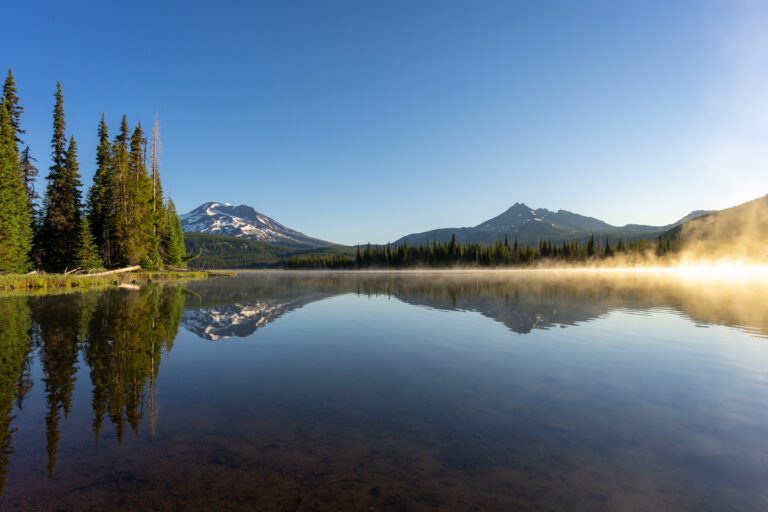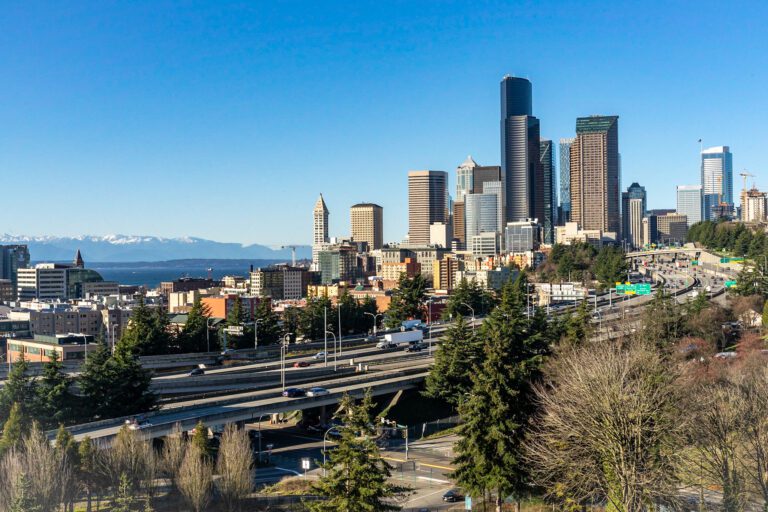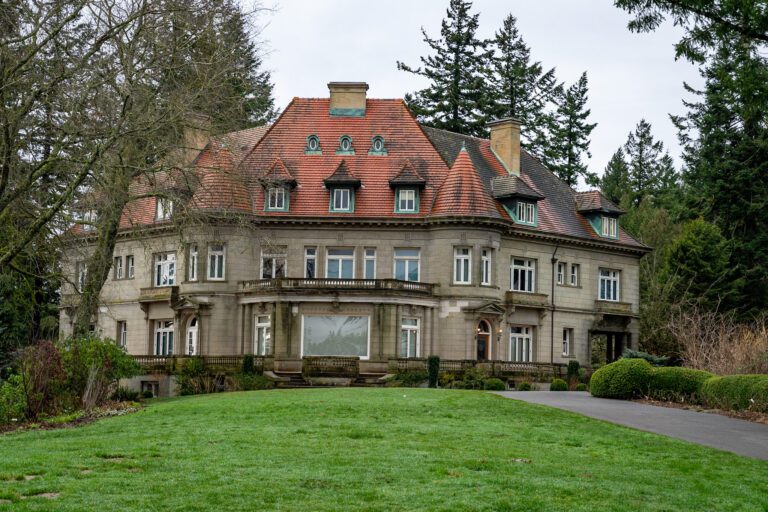How to Plan an Amazing Crater Lake National Park Itinerary
As the only national park in the state of Oregon, Crater Lake gets a lot of attention by locals and tourists alike. So what’s the big fuss? Oh, it’s only the deepest lake in the United States, unbelievably clear and blue, and was formed when a 12,000 foot volcano erupted over 7,000 years ago! Y’all—it’s very cool and if you find yourself in the vicinity you should have to check it out.
As you might expect, a place like this is very popular so you’ll need to put a little effort into planning a trip. I’ve put together a top notch Crater Lake itinerary that takes you to all the cool spots so you won’t miss a thing. So, while you may not be able to avoid the crowds, you can ensure an action-packed, awe-inspiring visit! Below you’ll find everything you need to know about this majestic lake and how to make the most of your visit.
Confession: the first time I visited Crater Lake was less than ideal, and even as a near-native Oregonian it wasn’t until I was an adult that I finally made it there.
The plan was to hike the Oregon portion of the PCT, and it would have been epic if not for the mosquitos. I have spent countless days and nights living in the woods and can handle a fair amount of pests, but these were downright tortuous. It was pure misery. They were SO BAD that we were forced to abandon our plans just a day away from Crater Lake!
Instead we hitchhiked to Medford, got a hotel room and the next day rented a car and headed up to Crater Lake. Would have been a lot cooler if we hiked in, huh? It wasn’t a total bust because we got to see the lake and hike around.
In this guide, we’ll cover everything you need to plan your Crater Lake itinerary – when to visit, how to get there, and the best things to do in Crater Lake National Park (with detailed guides to one or two days in the park).
Planning a trip to Crater Lake National Park? Don’t miss our guide to hiking in Crater Lake National Park, and our guide to planning an incredible Seattle to Crater Lake road trip.
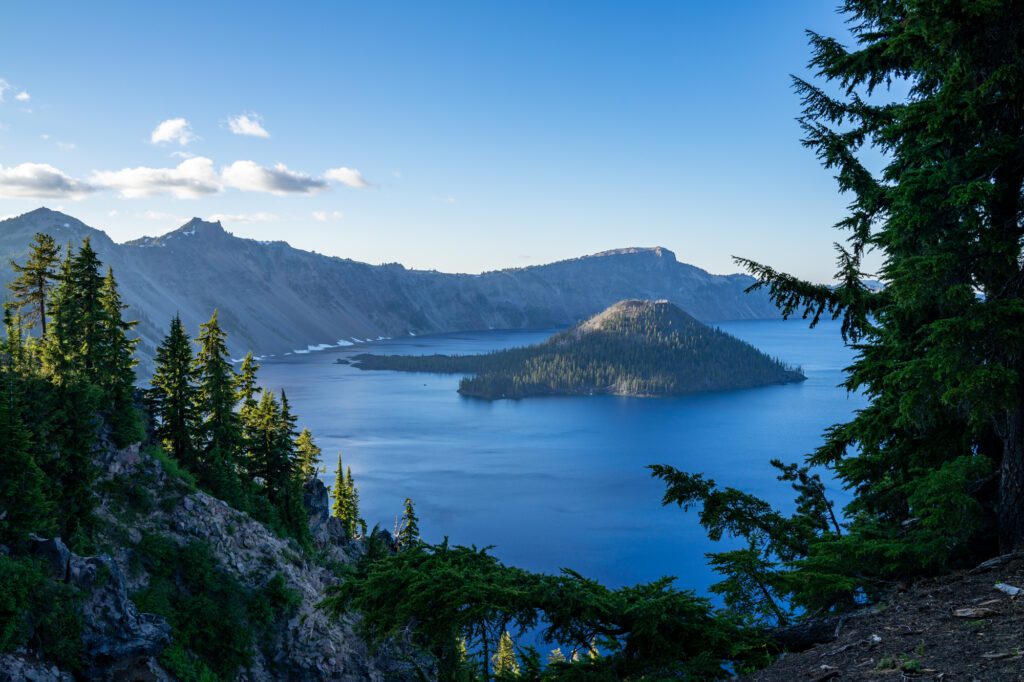
Disclaimer: Some of the links in this post, like hotel and vacation rental links, are affiliate links, meaning at no additional cost to you we make a little bit of money if you click through and book. That being said, we would absolutely never recommend something to you that we don’t stand behind 100%.
What Exactly is Crater Lake?
Some 7,700 years ago, Mount Mazama (then 12,140 feet tall), blew her top and the resulting caldera was filled in with melted snow and rain. The Makalak people, native to the land, had revered this mountain and the area was believed to be a temporary camp for the tribe and its later descendants, the Klamath.
Mazama’s eruption was seen as the end of a bitter fight between the Chief of the Above World and Chief of the Below World. Archeologists have since found various artifacts including sandals buried under the eruption.
It wasn’t until 1902 that Crater Lake officially became a national park and received protection from the federal government to ensure its wildlife and natural land are preserved for future generations to enjoy.
The lake itself (the deepest in the U.S., and 7th deepest in the world) was originally found to be 1,996 feet deep back in 1886, but as this was done by some dudes with a weight attached to a piano wire, the more commonly accepted max depth is 1,943 feet taken in 2000. Either way—that’s deep!
The actual depth from year to year varies though since the lake is fed entirely through rain and snow melt. Because of its location no inlets run in or out of it, contributing to its crystal clear waters.
The surface of the lake sits at 6,176 feet with Mount Scott reigning over the park at 8,934 feet (but, man—what it must have been like to see Mazama in all its glory!).
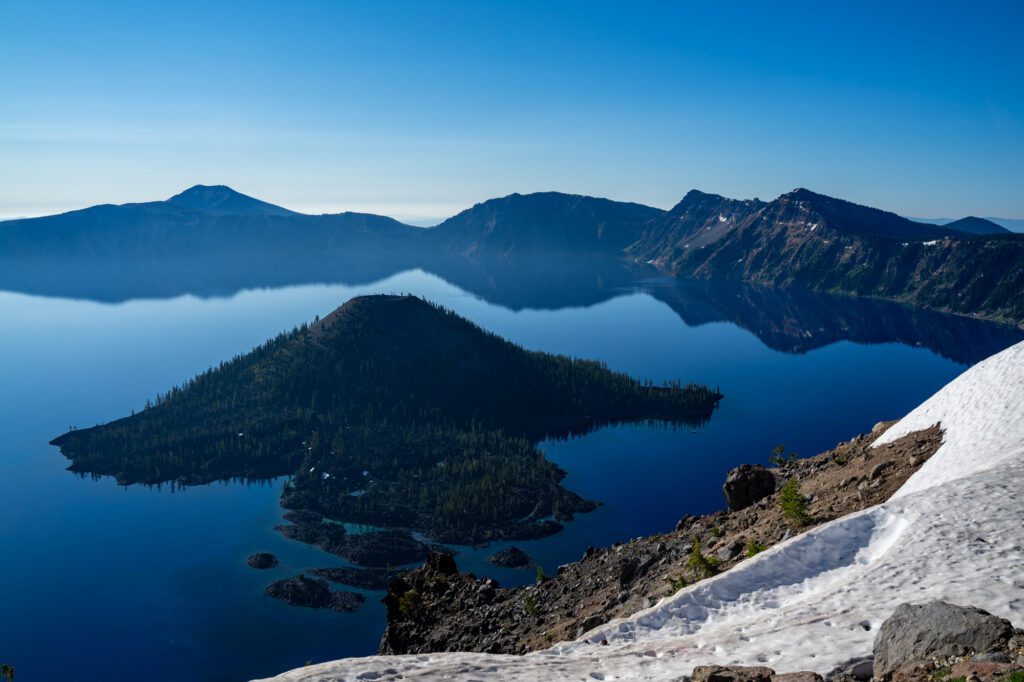
How Many Days Do You Need in Crater Lake?
Ideally, you should spend at least one full day and one night at Crater Lake. Getting here can be a bit of a hassle (far away and long lines to get in the actual park), so once you actually do make it, you don’t want to worry about getting back in your car and heading back if you can help it.
Can You Do a Day Trip to Crater Lake National Park?
Yes, but it depends on your definition of “day trip,” and where you’re coming from.
If you’re not staying in the park, I wouldn’t recommend more than a two hour commute to get here.
That means you need to start out (ideally) in one of the southern Oregon towns like Grants Pass, Medford, or Ashland (and of the three I’d recommend Ashland—it’s hella cute).
Roseburg and Bend are also doable, but you’re looking at 2 ½ to 3 hours each way and that sounds exhausting to me.
If you only have one day at Crater Lake and have to make it back to a city like Medford or Bend, get there as early as possible.
While Crater Lake is incredible and there are some stellar hikes to check out, it’s really only a two-day-tops kind of trip. I think this makes planning what to do in Crater Lake National Park a bit easier since you won’t be overwhelmed with options.
Tips for Visiting Crater Lake National Park
- Just because you’re in the park doesn’t mean you can always see the lake (the whole park is over 180,000 acres and there are lots of things to do at Crater Lake that don’t involve the actual lake).
- It’ll take you longer to get there than you think because of wait times to get through the entrances. Make sure you’ve got good tunes or podcasts to keep you entertained.
- Start with a full tank of gas. There’s only one gas station in the park.
- Bring snacks! There are places to get food but they may be closed and/or too busy and you don’t want to get hangry. Plus . . . none of them are anything to write home about.
- If you want to camp or stay in the park, make your reservation waaaaaaay ahead of time.
- Don’t be fooled by the “short” hikes. Short ≠ easy.
- There’s a $30 entrance fee for passenger vehicles, but the park also accepts the America the Beautiful pass that can get you into national parks across the country—road trip!
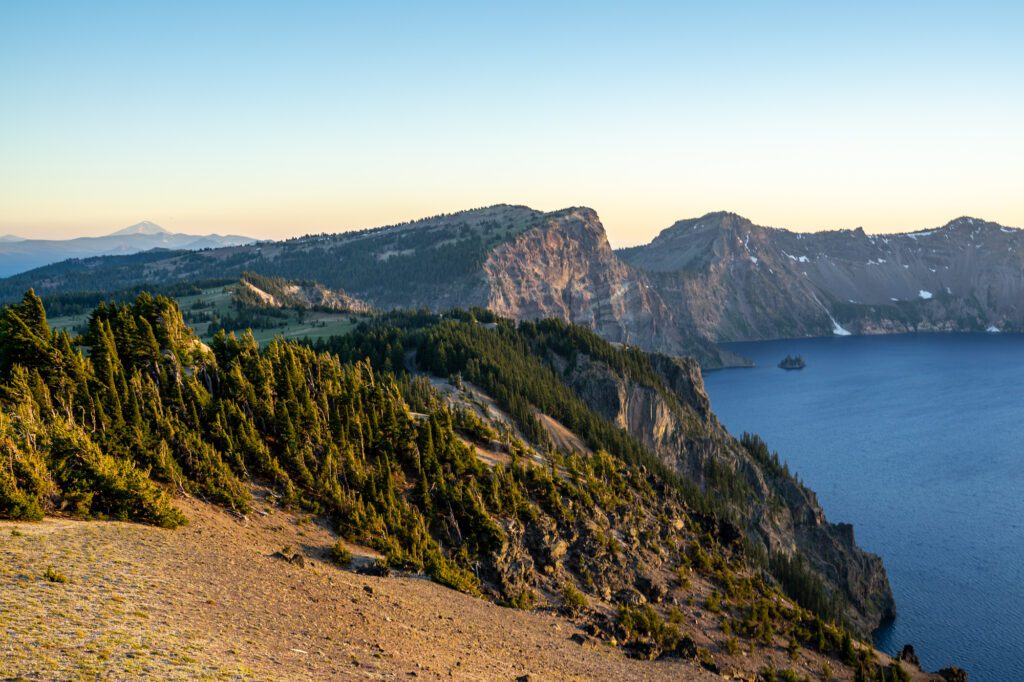
A Complete Guide to Planning Your Crater Lake Itinerary
Alright, let’s get into the actual itinerary.
We’re going to give you two versions – one that covers the best things to do in Crater Lake with 2 days, and a version with what to do in Crater Lake in one day.
There is some overlap between the two – some of my favorite things to do show up in both – but we wanted to give you a detailed option for both amounts of time in the park.
The Best Things to Do in Crater Lake National Park in 2 Days
The best part about spending more than one day at Crater Lake is getting to experience it either early in the morning or at sunset. However, finding a place to stay in the park is easier said than done.
The last section outlines your options and while there are walk-up tent sites, with the amount of visitors the park sees every year someone’s going to get the shaft.
Here’s your two-day Crater Lake National Park itinerary:
Day 1: Visitor’s Center, Rim Drive, Sunset Hike Up Watchman
On your first day, get acquainted with the park by stopping at the visitor center on the south rim and circumnavigating the lake along the rim road. Finish by watching the sun dip below the horizon from the Watchman.
Stop by the Visitor Center
Once you get to Rim Village, stretch your feet and take in the oh-so-blue water of Crater Lake. Then hit up the Rim Visitor Center if you’re there in the summer (it’s closed the rest of the year, but you can always go to the Steel Visitor Center which is open year round.
Steel is not right next to the lake, but is still worth a visit.) Maybe it’s just me, but I love chatting up rangers and seeing those big relief maps of the area and buying tacky tchotchkes.
Drive the Rim
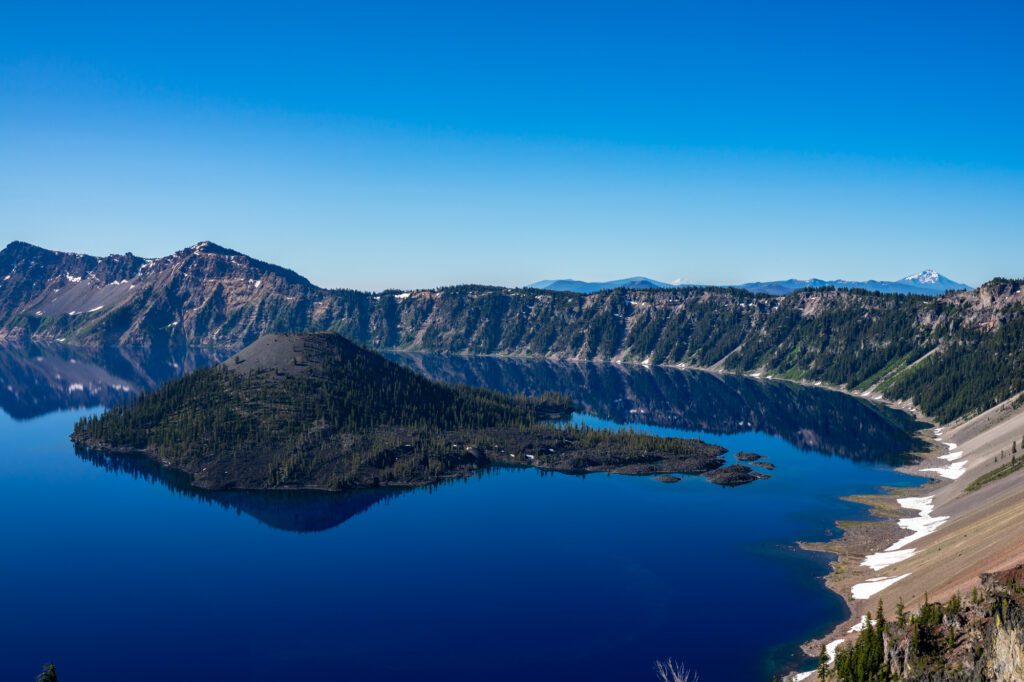
After you’ve had some lunch (or bring your lunch in the car), it’s time to drive the rim! This is the scenic drive that puts all other scenic drives to shame.
Plenty of opportunities for oooing and ahhing and getting those Insta shots. Plus it will give you a good lay of the land.
There are over 30 pull-outs along this route, and you won’t have time (nor will you want to) stop at all of them, so here are some highlights. I’ve laid these going clockwise from Rim Village:
- 6.6 mile marker – Watchman overlook is a great option for sunset, gives you access to the hike up to the top, and looks straight out onto Wizard Island.
- 13.1 mile marker – Cleetwood Cove is a great spot for views, hikes, swimming, and it has bathrooms!
- 19.6 mile marker – The Mount Scott trailhead takes you to the highest point in the park.
- 23.5 mile marker – The Pinnacles Road turnout is a 7 mile detour but well worth it to see Plaikni Falls and Pinnacles Overlook (which are these hella cool “fossil fumaroles”)
Sunset Hike Up to the Watchman
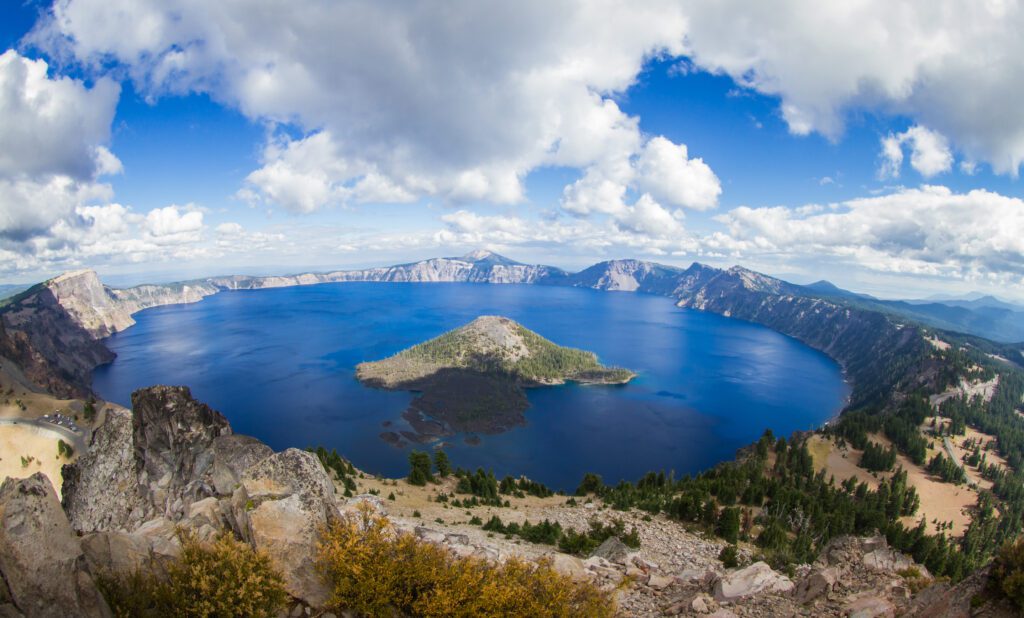
The Watchman trail is only 1.7 miles and is best done at sunset for unbelievable views. If you don’t feel like lingering too long at the top, you can probably watch the sunset then scramble back down before you lose daylight but I wouldn’t recommend it.
Bring a headlamp and a jacket because the temperature will start dropping after the sun goes down.
There are also ranger-led sunset hikes up Watchman if you’re at all nervous about navigation. If you’re traveling in the summer this means you’ll be heading out on your hike around 8:00 pm and coming down late.
Day 2: Mount Scott Hike, Cleetwood Cove + Boat Tour, Drinks with a View
On your second day, do two of the best hikes in Crater Lake that will take you to both the highest and lowest accessible points in the park. If you’re up for it, hop on a boat ride out to Wizard Island, the island in the middle of the lake, and then finish your day with some drinks with a view.
Hiking Mount Scott
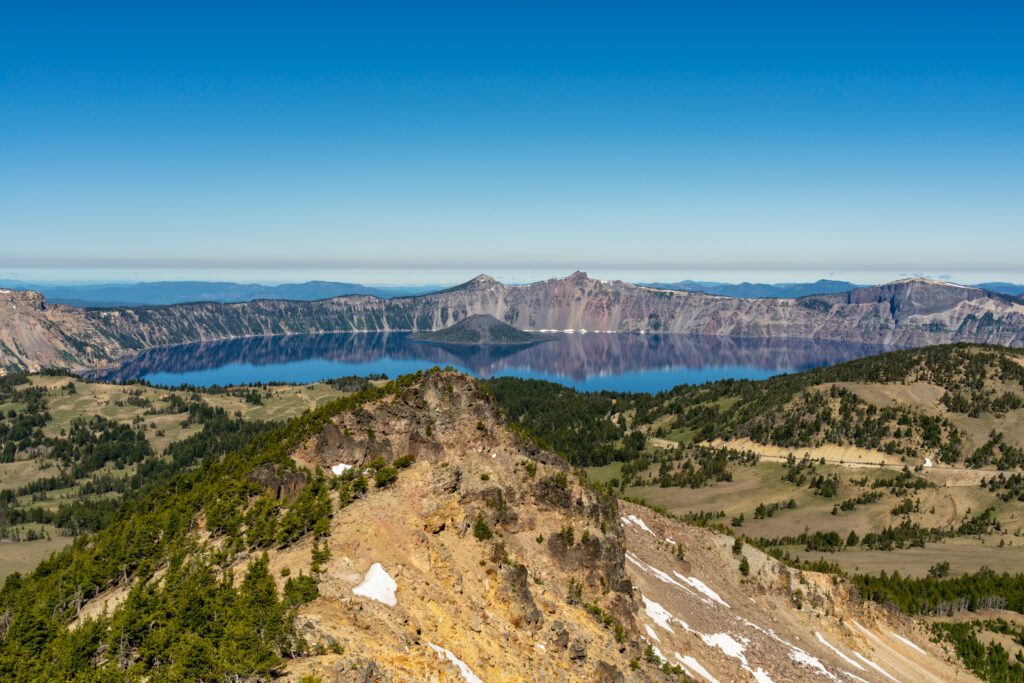
Start your day hiking up to the top of Mount Scott, probably the most challenging hike in the park (but not terribly difficult at 4.5 total miles).
The whole trail has very little tree cover, so if you’re visiting in the summer go early in the day to avoid the worst of the heat. Even so, you’re also likely to find patchy snow even in the summer.
The trail starts off fairly level, but then starts climbing steeply. In total you’ll be climbing 1,259 feet up to the summit but there are quite a few switchbacks that level out the grade.
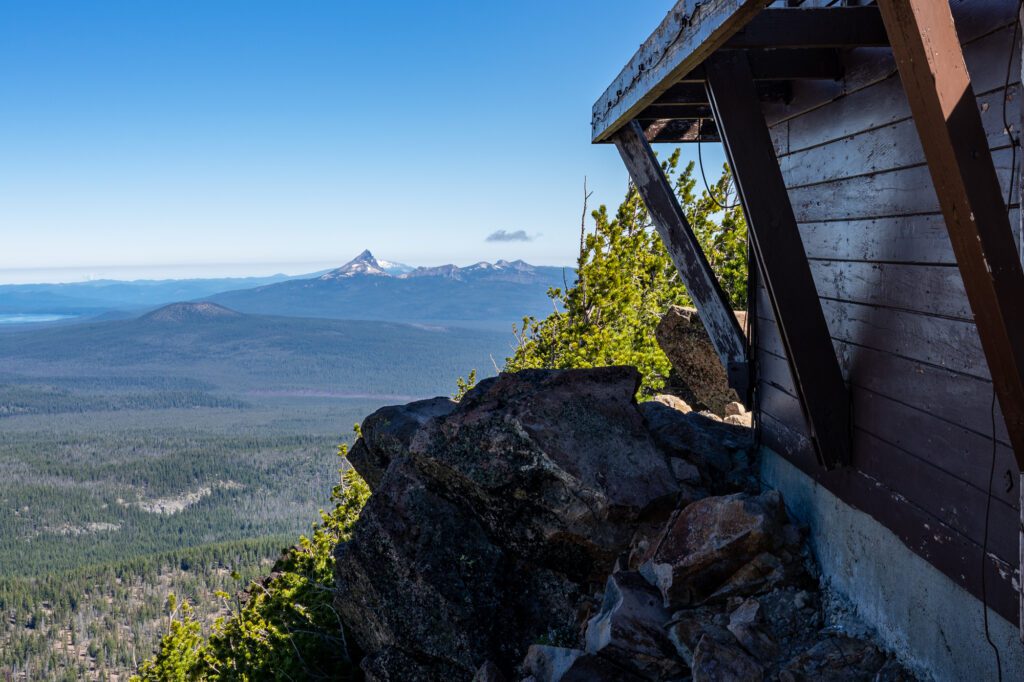
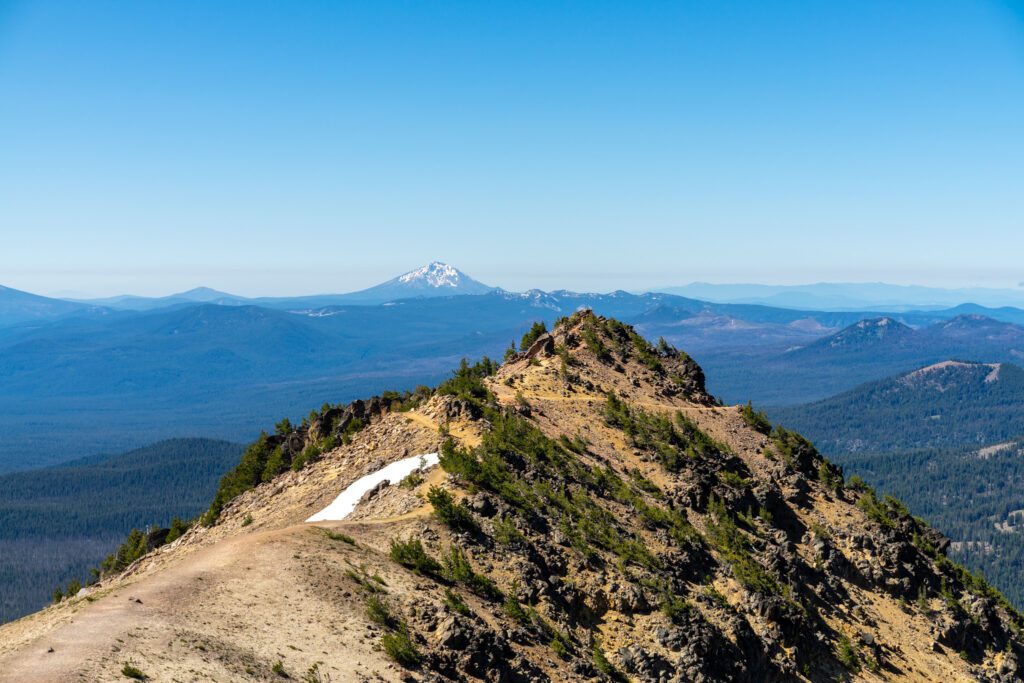
If you’re a photographer (and I’m not), I’ve heard this is the best location to get the entire lake into one frame. If it’s a clear day, you’re in for some spectacular views up and down the Cascades!
Cleetwood Cove with Optional (But Very Cool) Boat Tour
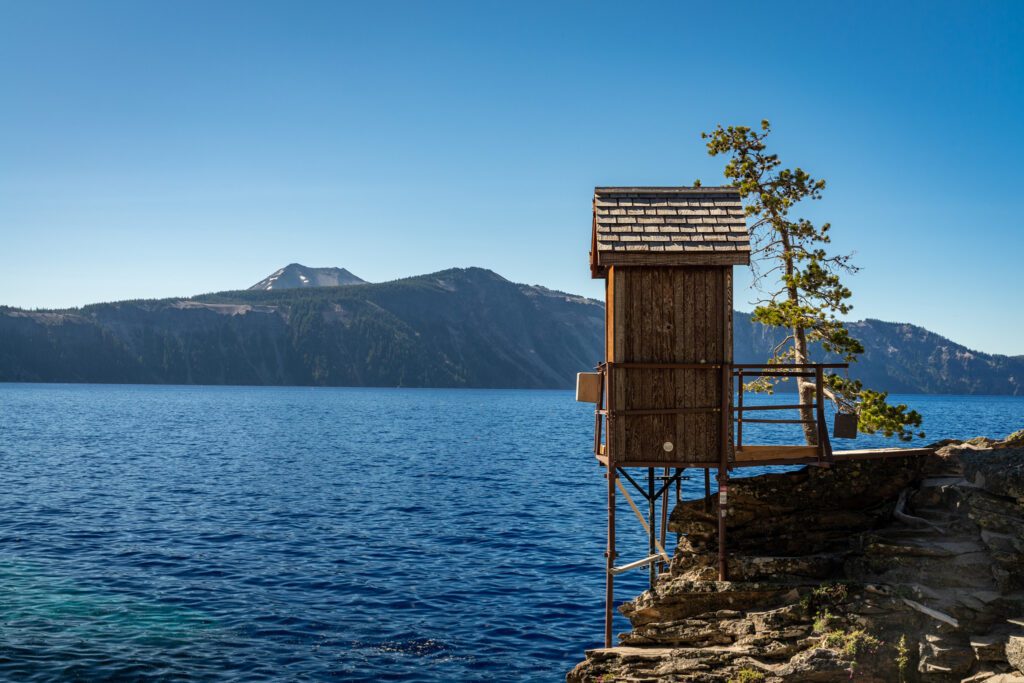
You’ll then go from the highest point in the park to the lowest! Become one with the lake by hiking down into Cleetwood Cove.
I’m always a fan of jumping into natural bodies of water and Crater Lake is no different. You’ll (almost) never regret it even though in summer the lake averages 57 degrees.
If semi-frigid water swimming isn’t your thing, maybe you should just jump in anyway so you can say you swam in the waters of an extinct volcano caldera?
If you can time the boat tour right you should do it, but remember to bring a jacket (and preferably a raincoat). It can be significantly colder out on the water and you’ll likely be splashed by the wake.
There’s an option to get dropped off at Wizard Island and hike around there, but then you have to wait until another boat comes by to pick you up and if they’re full you could be stuck for a while. It’s a cool idea, but is better reserved for those Crater Lake regulars who have done all the other hikes.
Drinks (and Dinner) With a View
Crater Lake Lodge only does a buffet style dinner and it’s pricey ($47). Is it the best meal I’ve ever had? Well, no. But, it’s all part of the experience.
AND, the real clincher about the lodge is their patio where you can get a drink, sit in a rocking chair and stare out over the lake (or if you’re lucky watch the sunset). What a great way to end your visit!
What to Do in Crater Lake National Park in a Day
Rest assured, you can enjoy the wonders of Crater Lake in one day, but you’ll have to stay focused! Aim to get there as early as possible to maximize your activities and decrease traffic. You’ll start seeing lines at the entrances around 9:00 am.
Get Oriented and Take a Hike!
When you get to the main parking area (called Rim Village), you’ll be right next to the lake and all the Visitor Center-y stuff. Do this first. There are incredible views just steps away from your car and checking out the maps in the Visitor’s Center will help orient you.
Next, you’re off to a hike! What you choose will depend on the weather and how much you want to exert yourself.

- For the best views, I recommend the 4.5 mile Mount Scott hike. Climb up to 8,934 feet and get sweeping views of the lake and surrounding area south to Mt. Shasta and north to Three Sisters. I’d say this hike is moderately difficult, but the trail is well graded and although there are a lot of switchbacks, it never gets too steep.
- For a good view but not as long of a hike, try the Watchman Trail. This shorter (1.7 mile) hike takes you up to around 8,000 feet for great views of the lake and especially Wizard Island. A good choice if you don’t have a ton of time, but want to move your body and take in the scenery.
- I love a good view, but when people ask me what to do at Crater Lake my first response is always the Cleetwood Cove trail. So, if you’d rather get up close and personal with the crystal blue water (and take an icy dip!) opt for the surprisingly difficult Cleetwood Cove trail. This is the only trail in the park that takes you down to the water and it’s straight down with no shade and loose rock underfoot. Only do this if you have good footwear (no flip flops!) and are in reasonable shape because the mile hike back up is brutal! It’s super cool to see the lake from this vantage point and if you can time it right you can take a boat tour either around the lake or over to Wizard Island.
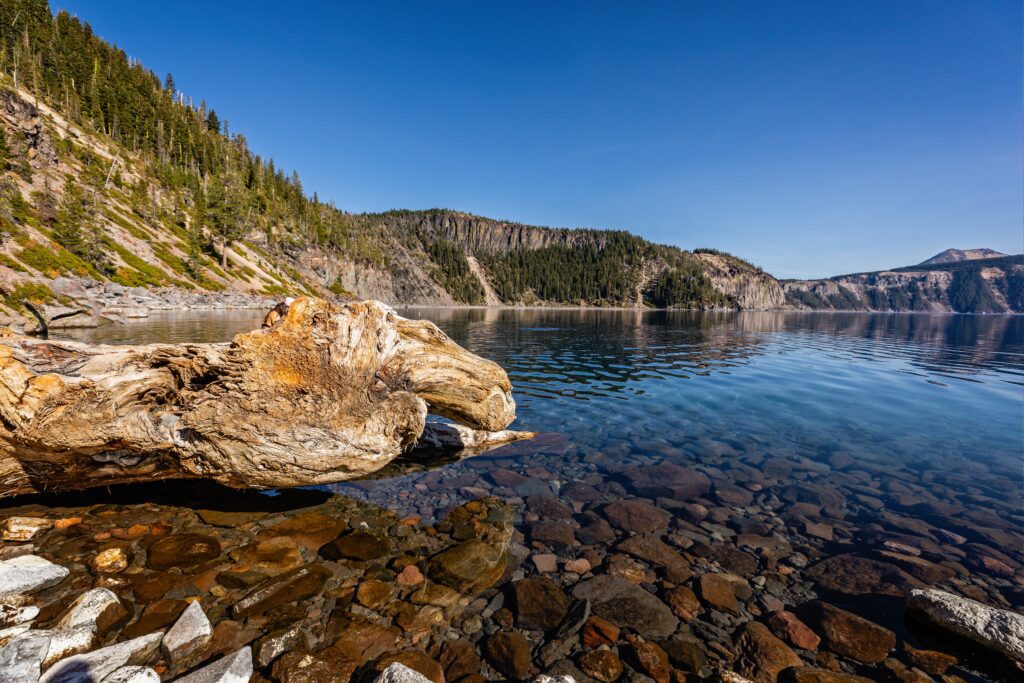
Drive the Rim
Rim Drive is a 33 mile long road that circumnavigates the lake. The road is split into the east and west portions, and they open at different times of the year depending on snowfall.
The west side typically opens a few weeks earlier (end of May or early June) than the east (late June or early July).
The only two months that you’re guaranteed the whole road will be open are August and September, but July and October you’ll have pretty good luck. Always check conditions.
I love a good road trip but I’m generally more of a get-out-there-and-explore-on-foot kind of gal. However, I thoroughly enjoyed driving around the rim. It’s one of the best things to do in Crater Lake National Park by far, and it’s accessible to anyone!
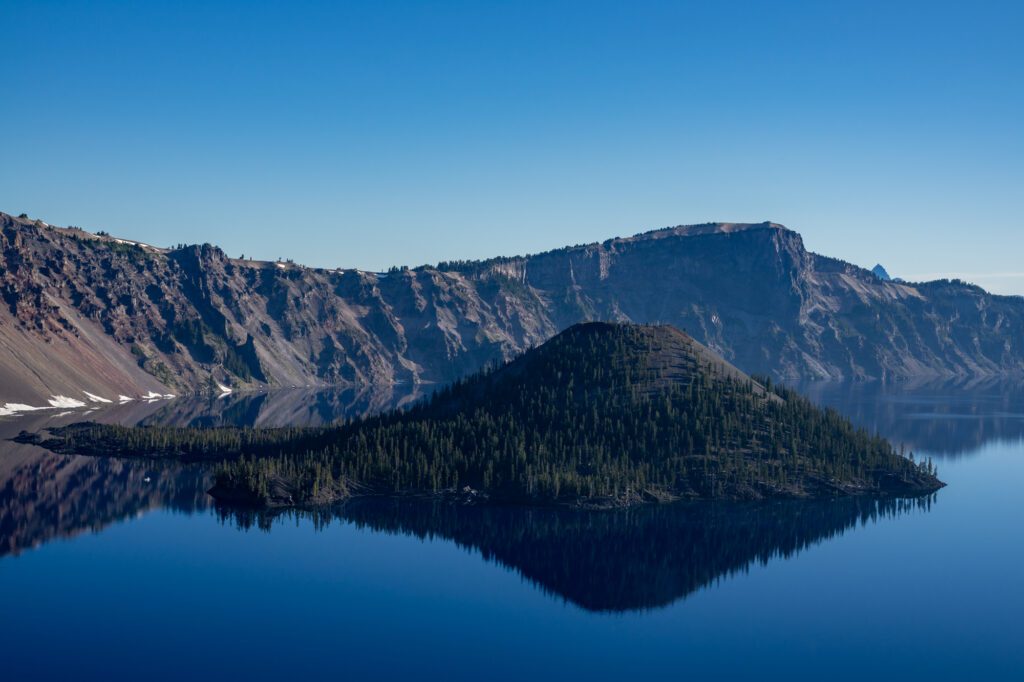
Do it after your hike and bring a snack to enjoy as you make your way around the lake. It sticks pretty close to the edge of the lake for countless views (more on the west side), and there are several pullouts to stretch your legs and take pictures.
Be aware that this road is narrow and windy and there’s no shoulder. If you’re driving a big RV or towing be very careful and consider unhitching first in the parking lot.
Rim Drive is also used heavily by bicyclists in the summer (and if you’re a cyclist you should check out Ride the Rim, two days in September that the east rim drive is closed to vehicles!)
If you don’t feel like driving, you can also take a trolley tour around the rim while a park ranger regales you with Crater Lake trivia!
More to Explore in Oregon
Enjoying this guide? We’ve got more Oregon travel guides to help you explore the best of Oregon and fall head-over-heels in love with it like we have.
- 25 Incredible Places to Visit in Oregon, the Best State in the Union
- How to Plan An Unforgettable Oregon Road Trip
- A Complete Oregon Coast Road Trip Itinerary
- 16 Incredible Hikes in Oregon
- One Day in Portland: The Best of Portland in a Day
- A Weekend in Portland: A Portland Itinerary for First Timers (Local’s Guide)
- Where to Stay in Portland: A Local’s Guide to 8 Areas to Stay
- The Best Hikes Near Portland (Local’s Guide)
- The Best Day Trips from Portland
- Amazing Weekend Getaways from Portland, Oregon
- The Best Things to Do in Hood River, Oregon
- What to Do in Cannon Beach: A Complete Getaway Guide
- How to Plan an Amazing Crater Lake Itinerary (1 or 2 Days)
- 24 Amazing Cabins in Oregon (Coast, Mountains, and More)
- Glamping in Oregon: 23 Cool Glamping Spots to Book for your Next Getaway
Where to Stay at Crater Lake
Camping in the park or staying in the lodge are the two best options by far, but there are a few solid alternatives if they’re booked.
Staying In the Park
Inside the park, you have a few options available, both camping and a historic lodge. They’re extremely competitive, so book as early as humanly possible.
Hotels and Cabins
Crater Lake Lodge is cool because it’s right there and certainly makes an early morning hike more doable. The rooms are nice and clean, but they’re not especially “lodge-y” to me (I want plaid and antlers everywhere).
The restaurant is fine and overpriced, but that’s kind of expected. However, the lounge and patio make up for the substandard fare. If you want to stay here, you have to book like a year in advance and that’s only a slight exaggeration.
There’s also the Cabins at Mazama Village which I’m a big fan of. No, they’re not right next to the lake, but they’re comfortable and honestly after a day elbowing your way through tourists at the lake, it’s nice to have a quieter place to sleep for the night.
Camping
Ideally you can snag a spot in the very large Mazama Campground. Both the cabins and the campground are about a 15 minutes drive from the lake, but they’re all well maintained and super convenient. You can reserve one online ahead of time, but they do hold back 25% of spots as first-come, first-served.
Lost Creek Campground is another good option if you can’t get into Mazama. Lost Creek is much smaller (16 sites compared with Mazama’s 214), and it’s entirely walk-up so there’s no way to reserve ahead of time. They’re considerably closer to the lake and more rugged than Mazama but still have picnic tables and bear boxes at each site.
Outside of the Park
If you can’t find a place to sleep inside of the park, there are still some good choices that are fairly close. All the options below are about a 30 minute drive from Crater Lake.
Hotels and Cabins
The Union Creek Resort is cute and rustic but not super fancy (read: no A/C or TVs, and the lodge rooms have shared bathrooms). I like this place because many of the cabins come with kitchenettes and as I’ve noted before the food options around the park are a bit underwhelming.
Another decent option is the Crater Lake Resort (note—not actually on Crater Lake). This place offers cabin rentals as well as glamping, tent sites, and RV sites and has a cute general store on site.
Camping
Diamond Lake Campground is an excellent choice if the campgrounds in the park are all overrun. There are 238 campsites and you’ll need a reservation for staying June 13 through August 31, but it’s first-come, first-served the rest of the year. The lake there is also lovely and less cold than Crater Lake.
Where is Crater Lake?
Crater Lake is in southern Oregon and sits in the Cascade range about 60 miles north of Klamath Falls and 90 miles south of Bend. And, if you were taking your road trip 8,000 years ago, Mt. Mazama (RIP) would have beat out Mount Hood as the tallest mountain in Oregon.
Getting to Crater Lake
Crater Lake is out of the way, but you’re visiting a national park so you kinda have to accept you’ll be spending some time in the car getting to your destination.
The park has three main entrances: the north, south, and west.
The north entrance is closed during the “winter,” and I have that in quotes because it’s actually closed seven to eight months out of the year. I’ve seen it closed clear into late June, so check conditions before you head out.
The south and west entrances are open year round barring extreme snow.
If you’re traveling outside of the summer months, be aware that the park gets a LOT of snow and if it’s been especially heavy, the roads may not be plowed for a week or more and you won’t be able to get to the top.
Again: check conditions. Many services will also be closed during the winter including the park’s only gas station, so fill up before you get here and bring snacks.
You should also schedule extra time for sitting in traffic waiting to get through the park’s entrances. On a nice summer day this could be upwards of an hour.
Pro tip: If you’re looking for directions and enter “Portland to Crater Lake,” or “Bend to Crater Lake,” you’ll get an inaccurate time estimate. For some reason this will only take you to the gate to get into the park, but to get up to the actual lake can often take you at least an hour longer. I recommend plugging in “Crater Lake Lodge” or “Rim Village” as your destination for the most accurate directions.
Driving From Portland
From Portland, take the 5 south down to Eugene, head east on the 58, then south on the 97. Stop for lunch at Stewart’s 58 Drive-In in Oakridge for a delicious grass-fed burger and sweet potato fries. Plan on at least five hours of drive time.
Note: from the 97, your route will depend on whether the north entrance is open. If it is, you’ll only be on the 97 a short while before heading west on the 138 which takes you to the north entrance. If it’s closed, you’ll have at least an hour more to drive as you continue down the 97 past Crater Lake and then backtrack up the 62 (also called Crater Lake Hwy).
Driving From Seattle
Another long day and you’ll likely want to head straight to your lodgings when you get there. Basically you’ll use the same directions from Portland but add 3 ½-ish hours to get from Seattle to Portland. Your main objective with this drive will be to avoid traffic.
I’ve made it between the two cities in 3 ¼ hours and I’ve done it in 4 ½.
If you wait for lunch until after you’re south of Portland there’s an In-N-Out Burger just north of Salem—just sayin’!
Driving From San Francisco
As you may expect this is a longer drive, but still doable in a day if you ask me! Plan on at least seven hours of drive time if you’re doing it in a straight shot.
The fastest route is unfortunately and predictably not the most scenic. The coastal route is absolutely gorgeous, but would probably require an over-nighter as you’d be looking at around 10 hours on the road.
From the Bay Area, head north on the 80 until you get to Vacaville, then continue north on the 505 until it intersects with the 5. You’ll stay on the 5 until you veer right onto the 97 north at Weed.
I recommend lunching in Mt. Shasta ( about 4 hrs from San Francisco) either at Seven Suns Coffee and Cafe or Pipeline Craft Taps and Kitchen. From Weed, stay on the 97 north until you get to the Crater Lake Hwy and you’ll enter the park at the Annie Springs south entrance.
Flying to Crater Lake
If you choose to fly, you’re likely planning a longer vacation than just seeing Crater Lake. This probably means you’ll be flying into PDX (best airport in the country! Holla!), and you’ll need to rent a car to get down to the lake.
Technically there’s a closer airport in Medford (Rogue Valley International Medford Airport (MFR)), but unless you plan on spending more time in Southern Oregon, it might be easier just to drive from Portland. From MFR it’s about a two hour drive to the lake.
There’s also a small airport just north of Bend (Redmond Airport) but annoyingly there are no direct flights to it from PDX. There are direct flights from Seattle and San Francisco, so maybe you wanna plan a little vacay to Bend and incorporate a couple days down in Crater Lake? Sounds fun to me! From Bend to the lake is a two to three hour drive.
When to Visit Crater Lake?
The best time of year to visit depends on what you’re looking for and whether or not you have 4WD. The park is open year round, but visitation drops off steeply during the snowy months. And really, that’s the best way to think about your options for visiting: snow or no snow.
The busiest months of the year to visit Crater Lake are July, August, and September. These are also the months where you’ll get the best weather, almost-zero chance of snow, but it also means you’ll be fighting crowds.
That said, if you plan to spend more than a day here, it shouldn’t be too much of a drag since you’re ideally camping or staying nearby, and you can pop up to the lake first thing in the morning or stay for sunset without worrying about a long drive home.
Visiting in the winter months can be a serene and spectacular experience, much different than the bustling crowds of summer. See snow-covered Wizard Island (the volcanic cinder cone in the middle of the lake) and spend your day snowshoeing or cross country skiing around the park.
The downside of winter is that you might not get the best views of the lake as storms and fog can get in the way of your postcard worthy views.
While the south and west entrances are regularly plowed, you’re still likely to encounter icy and snowy conditions November through May (or June) as the lake sees an average of 42 feet of snow a year. Also note that Rim Drive (the road that circles the lake) is closed during the winter months or anytime there’s been heavy snowfall (which could be in June!). Again: check conditions.
MORE TO EXPLORE IN THE PACIFIC NORTHWEST
If you’re planning a trip to the Pacific Northwest, we’ve got you covered with all sorts of super detailed travel guides to our favorite places in Washington and Oregon.
- Seattle: Find the perfect place to stay in Seattle, use our itinerary and complete Seattle city guide to plan your weekend in Seattle (we also have a guide to one day in Seattle for shorter trips), find a new hike near Seattle to tackle, and plan your next day trip or weekend getaway.
- Portland: Get a local’s take on what to do in Portland and where to stay in Portland, plan your weekend itinerary (we also have a guide to one day in Portland for shorter trips), find the best hikes in and around Portland, and discover the best day trip and weekend getaway destinations.
- Road Trips: Explore the best of the Pacific Northwest on a 14 day Pacific Northwest road trip. Plan an amazing Washington road trip or Oregon road trip with our detailed guides, including a couple of itineraries that you can copy/paste.
- The Oregon Coast: Explore the best of the Oregon Coast on a 7 day Oregon Coast road trip. Discover the best hikes on the Oregon Coast, and figure out what to do in Cannon Beach and Astoria.
- Hiking in Oregon: Get a local’s take on the best hikes in Oregon, the most spectacular Oregon waterfalls, and dive deeper into each region with our guides to the best hikes at Mt. Hood, in the Columbia River Gorge, and more.
- Hiking in Washington: Add to your Washington hiking bucket list with our guide to the best hikes in Washington. Then dive into our regional hiking guides to discover the best hikes near Seattle, hiking at Mount Rainier, in Olympic National Park, in the North Cascades, and at Mount Baker.
- Mount Rainier National Park: Plan the perfect trip to Mount Rainier with our guides to the best things to do, the best hikes, and how to plan a perfect day trip to Rainier.
- Olympic National Park: Explore the best that Olympic National Park has to offer – the best hikes, a complete itinerary, and exactly where to stay in Olympic National Park.
- North Cascades National Park: The least visited of the National Parks in Washington, learn how to plan a perfect itinerary, and figure out the best hikes to add to your list.
- Crater Lake National Park: Discover the best that Oregon’s only national park (isn’t that crazy?) has to offer with our guide to planning your Crater Lake itinerary, and our guide to the best hikes in Crater Lake. Plus, a guide to planning an amazing Seattle to Crater Lake road trip.

